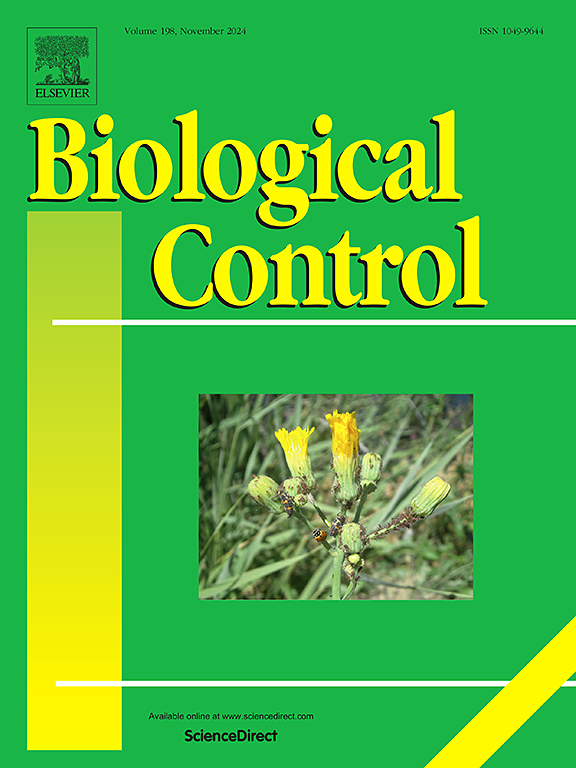Biocontrol potential of a novel broad-spectrum antifungal strain Bacillus velezensis Shannan.BV80-12 isolated from the Tibetan Plateau
IF 3.4
2区 农林科学
Q2 BIOTECHNOLOGY & APPLIED MICROBIOLOGY
引用次数: 0
Abstract
Plant diseases caused by pathogenic fungi are major contributors to global crop loss. Although chemical fungicides are effective for disease control, concerns regarding their adverse effects on human health and the environment have driven interest in sustainable alternatives. Beneficial microorganism-based biological controls have attracted considerable attention in this context. In this study, a novel bacterial strain, Bacillus velezensis Shannan.BV80-12, was isolated from the high-altitude Tibetan Plateau. The strain demonstrated significant inhibitory effects against 21 plant pathogenic fungi across 12 genera, showing inhibition rates between 61.9% and 97.5% in dual-culture assays and between 40.2% and 89.0% in poison agar assays with 2% cell-free supernatant. It also effectively controlled fungal plant diseases in detached leaf assays. Genome sequencing and analysis revealed the genetic basis for its biocontrol efficacy, including 19 biosynthetic gene clusters responsible for secondary metabolites and 23 glycoside hydrolase genes involved in degrading phytopathogen cell walls. UPLC-MS analysis of cell-free supernatants identified six distinct families of antimicrobial metabolites: fengycins (C14–C17), surfactins (C12–C16), iturins (C14–C16), bacillibactin, plantazolicin and bacilysin, suggesting that strain Shannan.BV80-12 possesses the capability to co-produce a variety of bioactive metabolites that synergistically contribute to its strong antimicrobial effects. Genome annotation and comparative genomics further revealed multiple genes associated with bacteria-plant interactions that can enhance plant health and resistance to pathogens, as well as genes crucial for adaptation to harsh environments, which may contribute to the stability and efficacy of the strain in controlling phytopathogens under adverse conditions. These findings elucidate the biocontrol mechanisms of B. velezensis strain Shannan.BV80-12 and support its potential application as a broad-spectrum biocontrol agent against phytopathogenic fungi in sustainable agriculture.
山南一株广谱抗真菌芽孢杆菌的生物防治潜力。BV80-12从青藏高原分离出来
病原真菌引起的植物病害是造成全球作物损失的主要原因。虽然化学杀菌剂对疾病控制是有效的,但对其对人类健康和环境的不利影响的关切促使人们对可持续替代品产生了兴趣。在这方面,有益微生物为基础的生物防治引起了相当大的关注。在本研究中,一种新的细菌菌株,velezensis山南。BV80-12是从青藏高原分离出来的。该菌株对12属21种植物病原真菌有明显的抑制作用,双培养抑制率为61.9% ~ 97.5%,含2%无细胞上清的毒琼脂抑制率为40.2% ~ 89.0%。在离体叶片试验中,对真菌病害也有较好的防治效果。基因组测序和分析揭示了其生物防治效果的遗传基础,包括19个负责次生代谢物的生物合成基因簇和23个参与降解植物病原菌细胞壁的糖苷水解酶基因。UPLC-MS分析鉴定出6个不同的抗菌代谢物家族:fengycins (C14-C17)、surfactinins (C12-C16)、iturins (C14-C16)、bacillibactin、plantazolicin和bacilysin,提示菌株山南属。BV80-12具有共同产生多种生物活性代谢物的能力,这些代谢物协同作用有助于其强大的抗菌作用。基因组注释和比较基因组学进一步揭示了与细菌-植物相互作用相关的多个基因,这些基因可以增强植物的健康和对病原体的抗性,以及适应恶劣环境的关键基因,这可能有助于该菌株在不利条件下控制植物病原体的稳定性和有效性。这些发现阐明了山南白僵菌的生物防治机制。并支持其作为一种广谱生物防治剂在可持续农业中的潜在应用。
本文章由计算机程序翻译,如有差异,请以英文原文为准。
求助全文
约1分钟内获得全文
求助全文
来源期刊

Biological Control
生物-昆虫学
CiteScore
7.40
自引率
7.10%
发文量
220
审稿时长
63 days
期刊介绍:
Biological control is an environmentally sound and effective means of reducing or mitigating pests and pest effects through the use of natural enemies. The aim of Biological Control is to promote this science and technology through publication of original research articles and reviews of research and theory. The journal devotes a section to reports on biotechnologies dealing with the elucidation and use of genes or gene products for the enhancement of biological control agents.
The journal encompasses biological control of viral, microbial, nematode, insect, mite, weed, and vertebrate pests in agriculture, aquatic, forest, natural resource, stored product, and urban environments. Biological control of arthropod pests of human and domestic animals is also included. Ecological, molecular, and biotechnological approaches to the understanding of biological control are welcome.
 求助内容:
求助内容: 应助结果提醒方式:
应助结果提醒方式:


